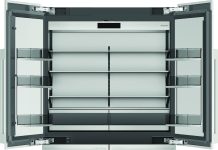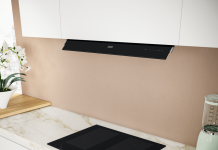Touchscreens that give information, implement controls and communicate with users. The technology of these systems is realized through three components: touch sensor and controller, LCD display and management software. Let us analyse their characteristics thoroughly.

Household appliances are becoming very complex and need a more and more communicative user interface, able to operate at various levels; on one hand they are requested to accept the various controls with a simple touch, on the other hand to communicate manifold information like the current operation status or the possible use choices in that specific condition.
The design of the user interface, in the last generation of household appliances, draws inspiration with increasing emphasis from the touchscreen technology, as source of a sensibly high quantity of information and as source of better control. The benefits deriving from it do not concern only users but also, and perhaps mainly, the manufacturer, needing a simple firmware to make the interface dialogue in all the languages of the world, without being charged with the burden of the numerous serigraphs to be applied on the household appliance according to the destination Country. Simplification well matching the further advantage of a simpler aesthetics care.
The introduction of technologies like the Smart Energy and the Smart Grid will exert a big impact on the type of information that will be shown, on “how” and “when”. Moreover, the standards under development will introduce a strong inter-operability among the various household appliances, letting a refrigerator communicate with the oven, the dishwasher or other household appliances, and all of them with the meter and the remote diagnostics. Information supplied in real time by household appliances will guide users’ choices concerning the energy use.

CREDIT PLAVNI.COM
Touchscreen interface
Three are the components that form a touchscreen: the system composed by the touch sensor and by the touch controller, the LCD display and the management software. The basic components remain unchanged, no matter whether we are dealing with a notebook, a portable phone or a control panel for household appliances.
The sensory panel is covered by a transparent front with the function of protecting from external agents, like wetness and dusts and mechanical damages such as scratches and small shocks.
The touchscreen, in the strict sense, is composed by a net of sensors protected by a sandwich of transparent glasses. It is positioned close to the LCD screen, so that the active area is perfectly superimposed to the visible area of the screen, conveying the neat impression of acting on the image to the operator.
There are different technologies to implement the sensitive part but, generally, the operation principle resides in the change of a voltage or a signal triggered by touching the sensitive part; this physical variation is detected by the controller that identifies its position.
The touch-controller is generally a supervision chip whose task is collecting the information produced by the sensitive surface and conveying them to the embedded control system (or to the PC) in a given format.
The almost totality of touch systems work in combination with LCD screens, chosen for their traditional qualities such as the good resolution, the image clarity and the refresh speed.
The software for the touchscreen management can be already contained in the operating system of the device (as it happens in PC touch) or it can be an add-on if the panel is added afterwards to the system as in mechatronic integrations.
The software allows the system formed by the controller and by the panel to work with coordination, i.e. to interpret correctly the events occurring at the touch time, comparing the information displayed by the screen with the coordinates of where the pressure took place; in trivial terms, we might say that in practice they carry out the functions of the conventional mouse.

CREDIT BAANTO
Touchscreen technologies
The touchscreen is a consolidated technology that allows users to interact with the operating system through the graphic interface, without using a keyboard but with the only touch of the fingers. Apart from sizes and peculiarities, the main distinction is between resistive touchscreen and capacitive touchscreen.
The resistive touch technology is the cheapest of the available ones, it has the quality of being very precise and it is insensitive to the presence of wetness and dust.
The screen is composed by two layers of plastic material coated by very thin conductive grids, separated by an insulating layer (all that transparent for the user). When you exert a pressure with the finger or a pen point on the outer layer, an electric contact with the underlying one is created, thus permitting the operating system to identify the XY coordinates of the contact point that generates an analogue voltage corresponding to the horizontal and vertical coordinates; these voltages are converted by the controller into digital signals, generating the desired response. Each contact point corresponds to one pixel, therefore the higher is the resolution the better will be the touch sensitivity and then precision.
Since this touchscreen simply reacts to a pressure, it can therefore be activated also wearing a glove, thing that cannot be done on a capacitive screen.
Capacitive screens feature a clearer display compared to the previous family. In this type of screen, sensors are positioned at the four corners and detect the change of the capacitive value due to the pressure.
They are constituted by a glassy material panel coated by a layer of metal oxide (transparent for users). A voltage is applied at the four corners, creating a uniform electric field, when the finger touches the surface, a variation of the electric field is produced; the coordinates of the touch point are determined by measuring the voltage drop at the four sources. These touchscreens can be activated only by the pressure of the bare finger or of a conductive object.
The PCAP (Projected Capacitive) technology is an evolution of the previous one, it offers higher precision and even more transparent screens, besides, it provides the possibility of the simultaneous multi-touch.

CREDIT SKYTEAMHK
Implementation of touch panels
Both the resistive and capacitive technology use conductive grids made of ITO (Indium-Tin-Oxide) whose size is around 50 microns.
In the resistive sensor, under the flexible protective coating there is a first ITO layer corresponding to the conductors in X, there is a vacuum interposed layer and then a second ITO film corresponding to the conductors in Y. Four wires are connected with the panel, one for each side on the X layer and one for each side of the Y layer.
The touch is surveyed when the upper ITO track touches the lower one; the localization occurs in two sequential times. On the right X termination is applied a known voltage and the left termination is grounded, the voltage value in the point is read by the Y-axis during the contact, which then supplies the X-coordinate. The same process is repeated in specular way for Y, so identifying the exact position where the pressure occurred.
Resistive touchscreens have been implemented with five and eight wires, too, where the upper ITO layer has been replaced by one with very low resistance; the eight-wire model has been developed to attain a high resolution, allowing a better calibration of the device.
There are various contraindications in the use of the resistive technology, of which the low transparency of the flexible protection cover is the first. The measuring process of resistivity encompasses some implicit imprecisions. Besides, if ITO layers are not more than uniform, the resistance does not vary linearly any longer and reading errors are induced.
On the contrary, the capacitive PCAP technology has no mobile parts and the only parts interposed between the LCD screen and the user are the ITO layer and the glass, which anyway grant a total transparency. The sandwich is composed by the glass, the grid of sensors of the X-axis, a subtle insulation and the grid of sensors of the Y-axis of the glassy substrate. Connections are one for each sensor, therefore a panel composed by 5X per 6Y will have 11 connections and one 10X per 14Y will have twenty-four.
When a finger (or a conductive object) will approach the screen, a capacity between finger and sensor will be created and its value is small compared to the others of the device (about 0.5pf against 20pf); the sensitivity is such as to be anyway promptly detected. Due to the construction of the sensor grid, the touch of a finger simultaneously interacts with several sensors in X and in Y, then the software determines with accuracy the exact position of the finger, interpolating and interpreting the information received.
Since these displays have a grid of sensors, they can detect the simultaneous presence of more than one finger (up to ten); an unfeasible performance with the other technology. An example is valid for all, a PCAP touchscreen gives the possibility of playing a piano whose keys are projected on the display.
Three variations on the theme

CREDIT: AISPRO.COM
There are other three technologies theoretically used in the implementation of touchscreens: infrared, acoustic waves and piezoelectric.
In the first, the external frame is composed by a sequence of infrared emission diodes positioned on two of the sides to which refers a series of phototransistor sensors from the opposite side. The system that controls the diodes emits a sequence of pulses, giving birth to a net of IR rays that cover the panel. When an object interrupts the beam, on the side of phototransistors is generated a signal destined to the control unit that processes it as coordinate. They are very transparent but scarcely precise screens compared to the reference standard ones and also the response speed does not equal them.
The technology that exploits surface acoustic waves uses glass screens equipped with transducers that emit and receive two beams of acoustic surface waves (one horizontal the other vertical). When a finger or a stylus touch the glass, a portion of the signal is absorbed; this variation is analysed identifying the coordinates of the contact point. The technology produces very transparent high-precision screens but equally sensitive to the contamination from dust and filth.
Finally, piezoelectric screens use a glass with aluminium frame in whose inside, in the four corners, are positioned piezoelectric sensors. The glass enjoys a certain degree of freedom, therefore when we exert a pressure on it, we create an unbalancing detected by sensors and sent as analogue signal to the control unit that digitizes it.
This device requires a high touch pressure and its hindrances are high cost and scarce precision.




